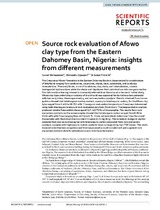| dc.contributor.author | Mohammed, Saeed | |
| dc.contributor.author | Opuwari, Mimonitu | |
| dc.contributor.author | Titinchi, Salam | |
| dc.date.accessioned | 2020-12-10T12:38:30Z | |
| dc.date.available | 2020-12-10T12:38:30Z | |
| dc.date.issued | 2020 | |
| dc.identifier.citation | Mohammed, S. et al. (2020). Source rock evaluation of Afowo clay type from the Eastern Dahomey Basin, Nigeria: Insights from different measurements. Scientific Reports, 10(1),12036 | en_US |
| dc.identifier.issn | 2045-2322 | |
| dc.identifier.uri | https://doi.org/10.1038/s41598-020-68918-y | |
| dc.identifier.uri | http://hdl.handle.net/10566/5497 | |
| dc.description.abstract | The Cretaceous Afowo Formation in the Eastern Dohamey Basin is characterized by an admixture of lithofacies ranging from sandstones, claystones, shales, clays, sand/shale, and sand/clay intercalations. The sandy facies, a mix of sandstone, clay, shale, and intercalations, contain biodegraded hydrocarbons while the shales and claystones that underlie it are rich in organic matter. The hydrocarbon-bearing interval is commonly referred to as the oil sand or tar sand. In this study, Afowo clay type underlying an outcrop of the oil sand was appraised for its hydrocarbon potential with loss on ignition, thermogravimetry, and rock evaluation pyrolysis. | en_US |
| dc.language.iso | en | en_US |
| dc.publisher | Springer Nature | en_US |
| dc.subject | Afowo clay | en_US |
| dc.subject | Nigeria | en_US |
| dc.subject | Sandy facies | en_US |
| dc.subject | Hydrocarbon-bearing interval | en_US |
| dc.subject | Dahomey Basin | en_US |
| dc.title | Source rock evaluation of Afowo clay type from the Eastern Dahomey Basin, Nigeria: Insights from different measurements | en_US |
| dc.type | Article | en_US |

